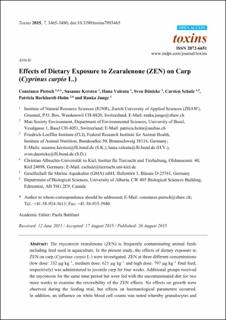Please use this identifier to cite or link to this item:
https://doi.org/10.21256/zhaw-1596| Publication type: | Article in scientific journal |
| Type of review: | Peer review (publication) |
| Title: | Effects of dietary exposure to zearalenone (ZEN) on carp (Cyprinus carpio L.) |
| Authors: | Pietsch-Schmied, Constanze Kersten, Susanne Valenta, Hana Dänicke, Sven Schulz, Carsten Burkhardt-Holm, Patricia Junge, Ranka |
| DOI: | 10.21256/zhaw-1596 10.3390/toxins7093465 |
| Published in: | Toxins |
| Volume(Issue): | 7 |
| Issue: | 9 |
| Page(s): | 3465 |
| Pages to: | 3480 |
| Issue Date: | 2015 |
| Publisher / Ed. Institution: | MDPI |
| ISSN: | 2072-6651 |
| Language: | English |
| Subjects: | Blood cell populations; Aquaculture; Feed quality; Genotoxicity |
| Subject (DDC): | 572: Biochemistry |
| Abstract: | The mycotoxin zearalenone (ZEN) is frequently contaminating animal feeds including feed used in aquaculture. In the present study, the effects of dietary exposure to ZEN on carp (Cyprinus carpio L.) were investigated. ZEN at three different concentrations (low dose: 332 mg kg-1, medium dose: 621 mg kg-1 and high dose: 797 mg kg-1 final feed, respectively) was administered to juvenile carp for four weeks. Additional groups received the mycotoxin for the same time period but were fed with the uncontaminated diet for two more weeks to examine the reversibility of the ZEN effects. No effects on growth were observed during the feeding trial, but effects on haematological parameters occurred. In addition, an influence on white blood cell counts was noted whereby granulocytes and monocytes were affected in fish treated with the medium and high dose ZEN diet. In muscle samples, marginal ZEN and α-zearalenol (a-ZEL) concentrations were detected. Furthermore, the genotoxic potential of ZEN was confirmed by analysing formation of micronuclei in erythrocytes. In contrast to previous reports on other fish species estrogenic effects measured as vitellogenin concentrations in serum samples were not increased by dietary exposure to ZEN. This is probably due to the fact that ZEN is rapidly metabolized in carp. |
| URI: | https://digitalcollection.zhaw.ch/handle/11475/2357 |
| Fulltext version: | Published version |
| License (according to publishing contract): | CC BY 4.0: Attribution 4.0 International |
| Departement: | Life Sciences and Facility Management |
| Organisational Unit: | Institute of Natural Resource Sciences (IUNR) |
| Appears in collections: | Publikationen Life Sciences und Facility Management |
Files in This Item:
| File | Description | Size | Format | |
|---|---|---|---|---|
| 2015_Pietsch-Schmied_Effects of dietary exposure_Toxins.pdf | 617.31 kB | Adobe PDF |  View/Open |
Show full item record
Pietsch-Schmied, C., Kersten, S., Valenta, H., Dänicke, S., Schulz, C., Burkhardt-Holm, P., & Junge, R. (2015). Effects of dietary exposure to zearalenone (ZEN) on carp (Cyprinus carpio L.). Toxins, 7(9), 3465–3480. https://doi.org/10.21256/zhaw-1596
Pietsch-Schmied, C. et al. (2015) ‘Effects of dietary exposure to zearalenone (ZEN) on carp (Cyprinus carpio L.)’, Toxins, 7(9), pp. 3465–3480. Available at: https://doi.org/10.21256/zhaw-1596.
C. Pietsch-Schmied et al., “Effects of dietary exposure to zearalenone (ZEN) on carp (Cyprinus carpio L.),” Toxins, vol. 7, no. 9, pp. 3465–3480, 2015, doi: 10.21256/zhaw-1596.
PIETSCH-SCHMIED, Constanze, Susanne KERSTEN, Hana VALENTA, Sven DÄNICKE, Carsten SCHULZ, Patricia BURKHARDT-HOLM und Ranka JUNGE, 2015. Effects of dietary exposure to zearalenone (ZEN) on carp (Cyprinus carpio L.). Toxins. 2015. Bd. 7, Nr. 9, S. 3465–3480. DOI 10.21256/zhaw-1596
Pietsch-Schmied, Constanze, Susanne Kersten, Hana Valenta, Sven Dänicke, Carsten Schulz, Patricia Burkhardt-Holm, and Ranka Junge. 2015. “Effects of Dietary Exposure to Zearalenone (ZEN) on Carp (Cyprinus Carpio L.).” Toxins 7 (9): 3465–80. https://doi.org/10.21256/zhaw-1596.
Pietsch-Schmied, Constanze, et al. “Effects of Dietary Exposure to Zearalenone (ZEN) on Carp (Cyprinus Carpio L.).” Toxins, vol. 7, no. 9, 2015, pp. 3465–80, https://doi.org/10.21256/zhaw-1596.
Items in DSpace are protected by copyright, with all rights reserved, unless otherwise indicated.